What is heard on the air? We receive and decode the most interesting signals
Hi, Habr.
It’s already the 21st century, and it would seem that data can be transferred in HD-quality even to Mars. However, many interesting devices still work on the radio and you can hear many interesting signals.

It’s unrealistic to consider all of them, we’ll try to choose the most interesting ones, those that can be received and decoded independently using a computer. To receive signals, we will use the Dutch online WebSDR receiver, MultiPSK decoder and Virtual Audio Cable.
For convenience, we will cite the signals in increasing frequency. I won’t consider broadcasting stations, it’s boring and banal, anyone can listen to Radio China in AM on their own. And we will move on to more interesting signals.
At a frequency of 77.5 KHz (long wavelength range), the exact time signals of the German station DCF77 are transmitted. There was already a separate article on them , so you can only briefly repeat that this is a simple structure signal in amplitude modulation - “1” and “0” are encoded with different durations, as a result, a 58-bit code is received in one minute.

At these frequencies, according to the radioscanner site , German electrical network control signals are transmitted.

The signal is strong enough, and according to reviews, it is accepted even in Australia. You can decode it in MultiPSK if you set the parameters as shown in the screenshot.
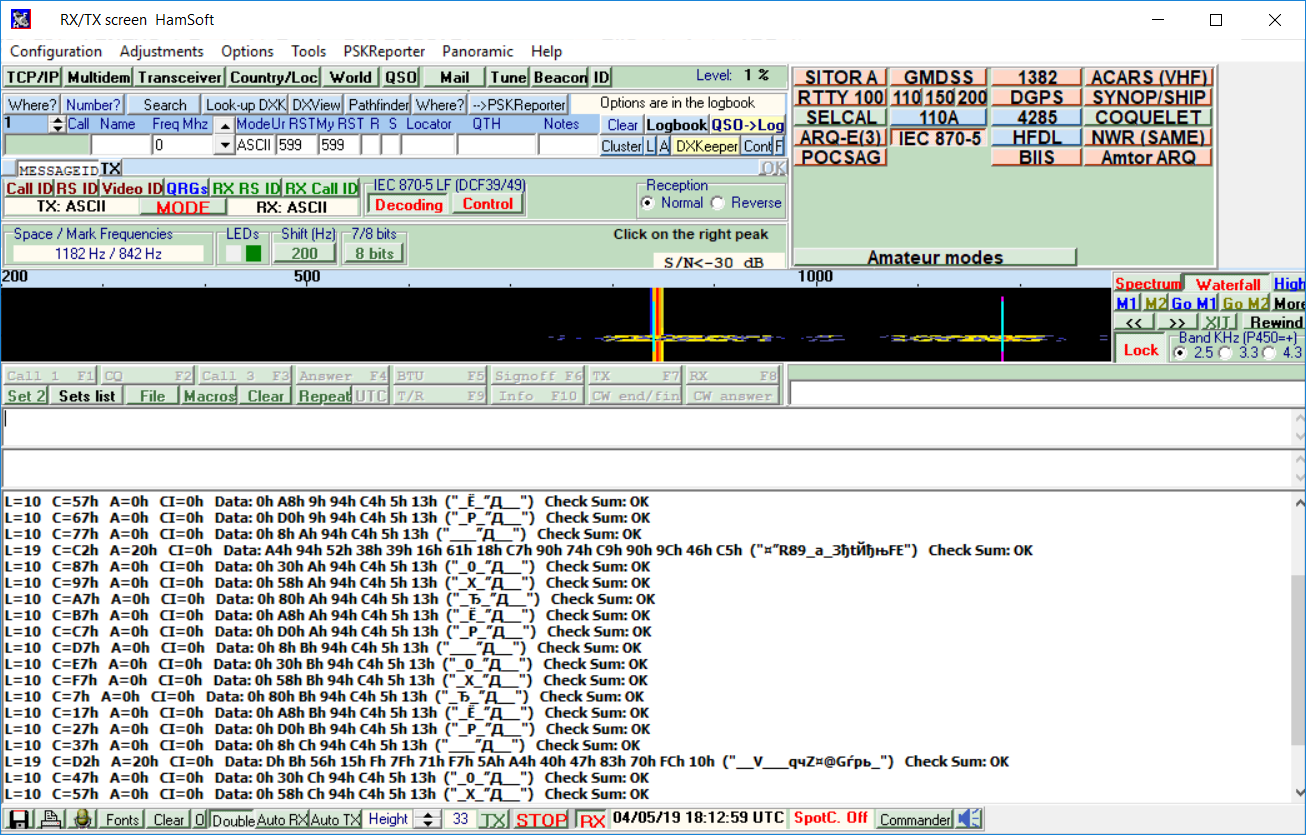
At the output we get data packets, their structure is, of course, unknown, those who wish can experiment and do analysis at their leisure. Technically, the signal itself is very simple, the method is called FSK (Frequency Shift Keying) and consists in the formation of a bit sequence by changing the transmission frequency. The same signal, in the form of a spectrum - bits can be counted even manually.

In the spectrum above, very close, at a frequency of 147 KHz, another signal is visible. This (also German) DWD (Deutscher Wetterdienst) station broadcasts weather reports for ships. In addition to this frequency, signals are also transmitted at 11039 and 14467KHz.
The decoding result is shown in the screenshot.

The principle of teletype encoding is the same, FSK, of which text encoding is of interest. It is 5-bit using the Bodo code , and has an almost 100-year history.

It seems that a similar code was used on punched tapes, but teletypes of weather have been sent out somewhere since the 60s, and as you can see, they still work. Of course, on a real ship, the signal is not decoded using a computer - there are special receivers that record the signal and display it on the screen.
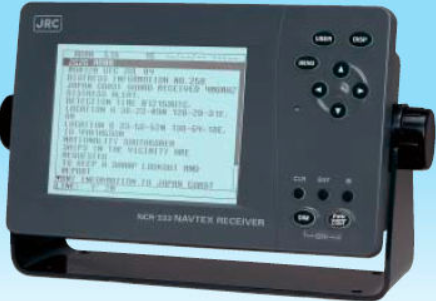
In general, even with satellite communications and the Internet, data transmission in this way still remains a simple, reliable and cheap means. Although of course, we can assume that sometime these systems will go down in history and will be replaced by fully digital services. So those who want to receive such a signal should not be very delayed.
Another legacy signal with about the same old history. In this signal, the image is transmitted in analog form at a speed of 120 lines per minute (there are other values, for example 60 or 240 LPM), frequency modulation is used to encode the brightness - the brightness of each image point is proportional to the frequency change. Such a simple scheme made it possible to transmit images back in those days when few people heard about “digital signals”.
Popular in the European part and convenient for reception is the already mentioned German DWD station (Deutche Wetterdienst), which transmits messages at frequencies 3855, 7880 and 13882KHz. Another organization whose faxes are easy to receive is the British Joint Operational Meteorology and Oceanography Center, they transmit signals at frequencies of 2618, 4610, 6834, 8040, 11086, 12390 and 18261 kHz.
To receive HF Fax signals, you need to use the USB receiver mode, for decoding you can use MultiPSK. The result of receiving through the websdr receiver is shown in the figure:
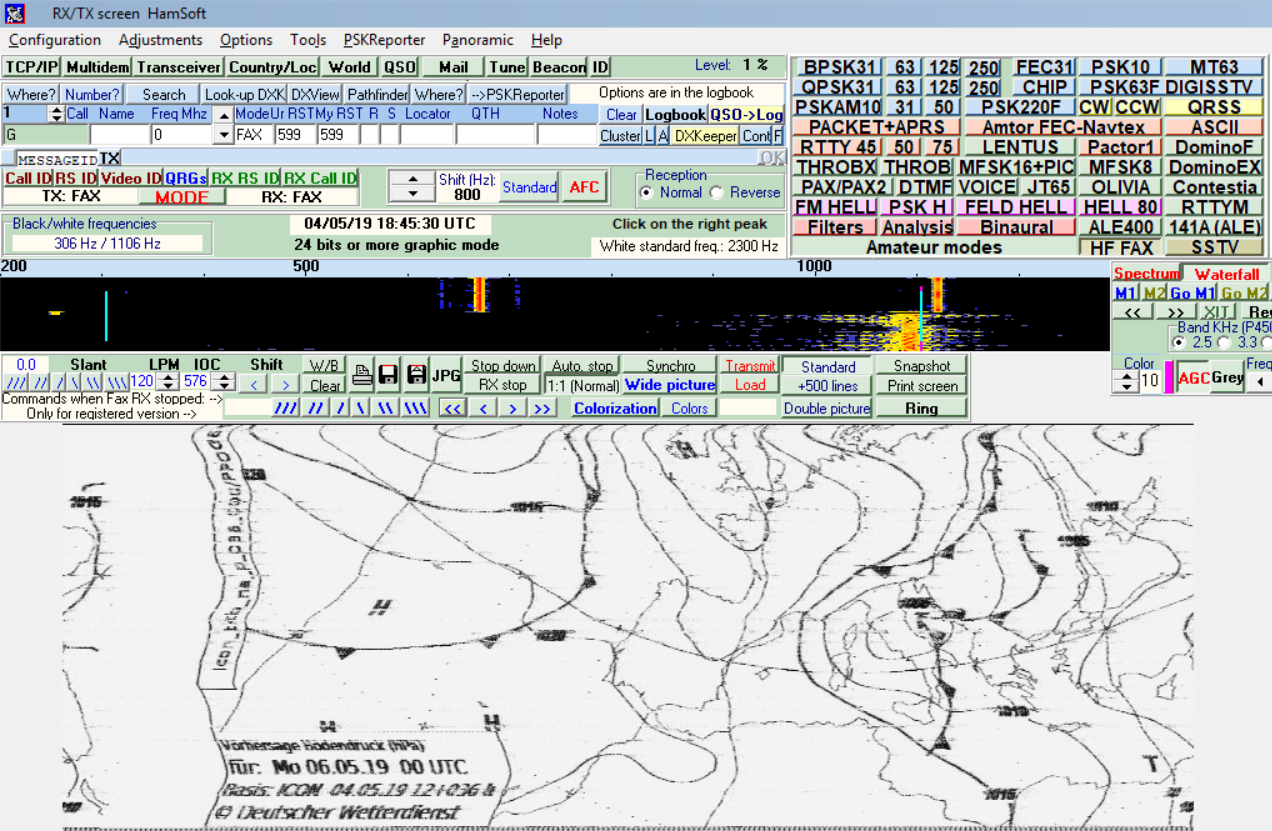
This picture was taken right at the time of writing the text. It can be seen by the way that the vertical lines have moved out - the protocol is analog, and the accuracy of synchronization is critical here, even slight delays in transmitting sound online cause image shift. When using a “real” receiver, this effect will not be.
Of course, as in the case of weather forecasting, nobody decodes faxes using computers on ships - there are specialized receivers (an example of a picture from the beginning of the article) that do all the work automatically.
Edit: as suggested in the comments, not only weather reports, but even newspapers are transmitted by fax . Frequencies and transmission schedules of different countries and regions can be found in pdf .
Consider now a more modern standard for short-wave data transmission - the Stanag 4285 modem. This format was developed for NATO, and exists in various versions. It is based on phase modulation, the signal parameters can vary, as can be seen from the table, the speed can be from 75 to 2400bit / s. This may seem a little, but given the transmission medium - short waves, with their fading and interference, this is a very good result.

MultiPSK can decode STANAG, but in 95% of cases the result of decoding will be only “garbage” - the format itself provides only a bit-level protocol of the lower level, and the data itself can be encrypted or have its own format. However, some signals can be decoded, for example, the recording below at a frequency of 8453KHz. I did not succeed in decoding at least some signal through a websdr receiver, apparently, online transmission nevertheless violates the data structure. Those who wish can download the file from a real receiver at the link cloud.mail.ru/public/JRZs/gH581X71s . The decoding results in MultiPSK are shown in the screenshot below. As you can see, the speed for this recording is 600bps, apparently, the text file is transferred as the content.

It is interesting that, as you can see in the panorama, there are really a lot of such signals on the air:

Of course, not all of them are possible, they belong to STANAG - there are other protocols based on similar principles. For example, the analysis of the Thales HF Modem signal can be given .
As in the case with the other considered signals, specialized devices are used for real reception and transmission. For example, for the NSGDatacom 4539 modem shown in the photo, the speed is declared from 75 to 9600bps with a signal bandwidth of 3KHz.
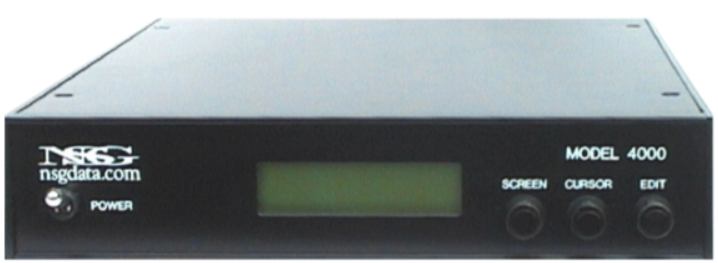
The speed of 9600, of course, is not very impressive, but given that the signals can be transmitted even from the jungle or from a ship in the ocean, and without paying anything to the traffic operator, this is not so bad.
Let’s take a look, more attentively at the panorama above. On the left we see ... right, the good old Morse code. So, move on to the next signal.
At a frequency of 8423KHz, we hear it. The art of hearing Morse code is almost lost now, so we will use MultiPSK (however, it decodes so-so, CW Skimmer does much better).
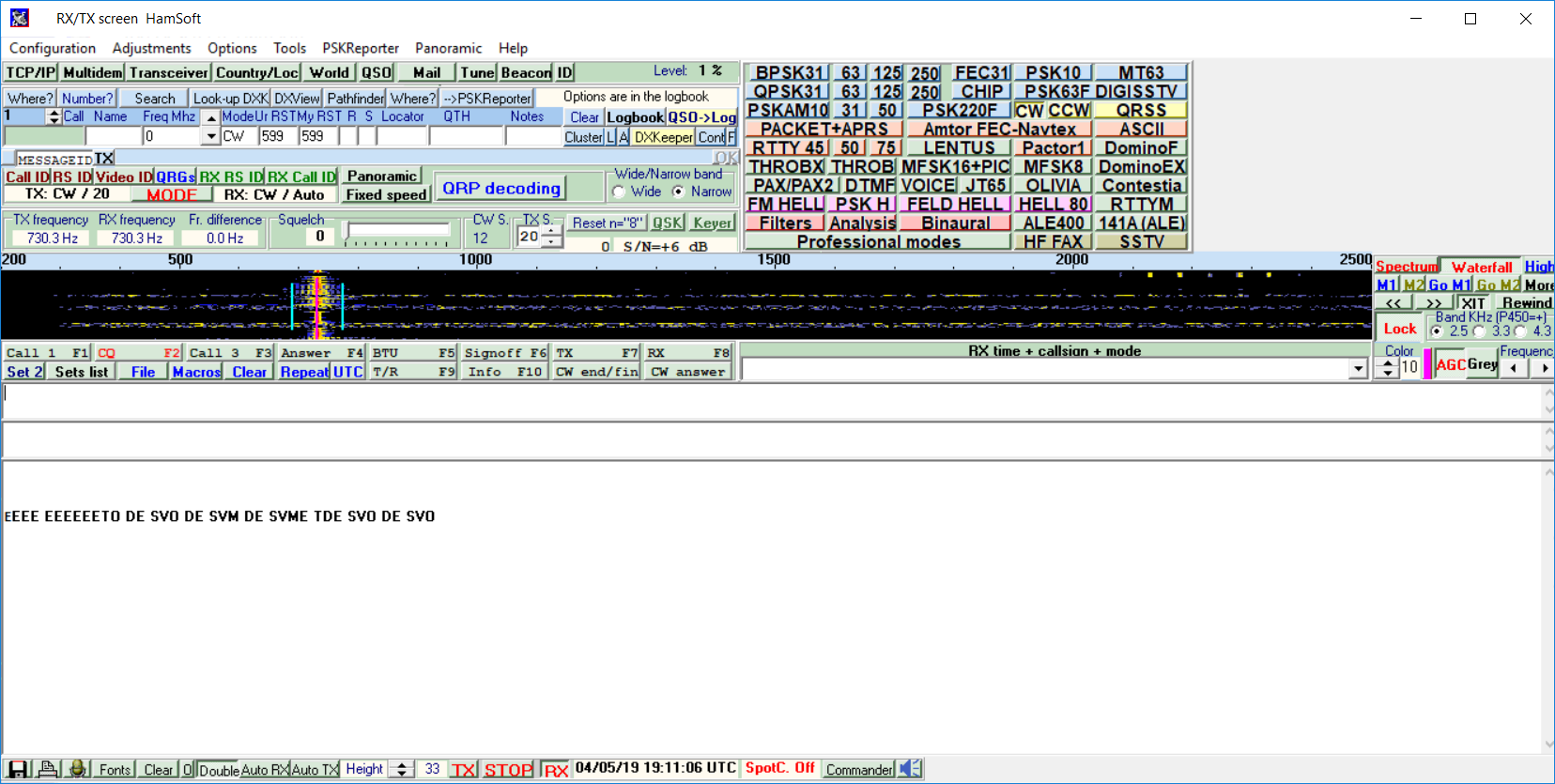
As you can see, the repeating text DE SVO is transmitted, according to the radioscanner site , the station is located in Greece.
Of course, there are already few such signals, but they still exist. As an example, we can cite a long-running station at 4331KHz, transmitting repeating signals “VVV DE E4X4XZ”. As prompted by Google, the station belongs to the Israeli Navy. Is anything else being transmitted at this frequency? The answer is unknown, anyone can listen and check on their own.
The most probably known one completes our hit parade, the signal is known both in Russia and abroad, the signal at a frequency of 4625KHz.
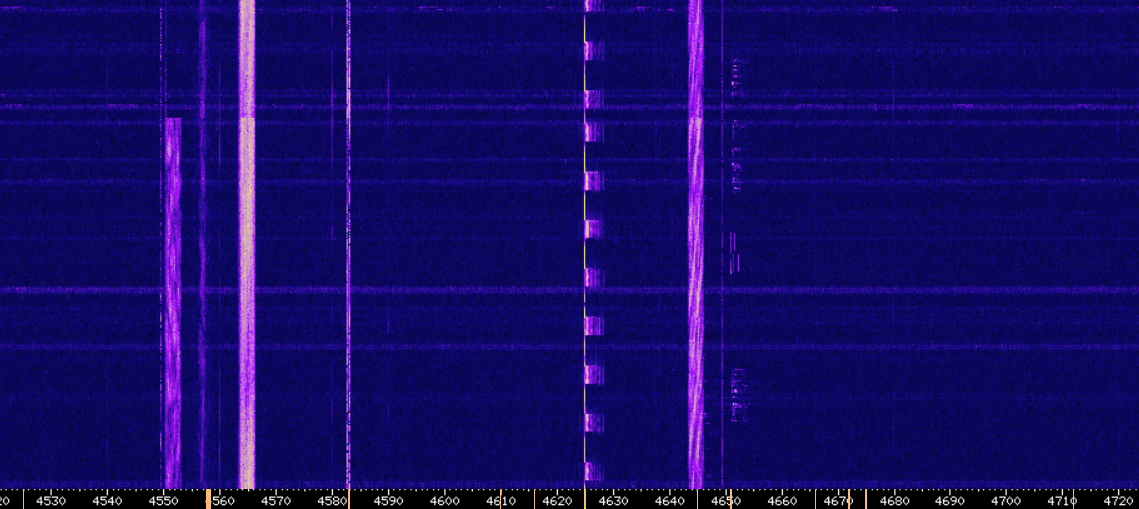
The signal is used to alert troops, and consists of repeated beeps, between which code phrases from the cipher block are sometimes transmitted (abstract words like “Bunny” or “Bramirka”). Some write that they saw such receivers in military enlistment offices, others say that this is part of the "dead hand" system, in general, the signal is a mecca for lovers of Stalker, conspiracy theories, the Cold War and other things. Those who wish can type “UVB-76” in the search, and I’m sure that entertaining reading for the evening is guaranteed (however, do not take everything written seriously). At the same time, the system is quite interesting, even if it’s still been working since the Cold War, although it’s hard to say whether anyone needs it now.
This list is far from complete. Using the radio, you can hear (or rather see) communication signals with submarines, and over-the-horizon radars, and rapidly changing frequency hopping signals, and much more.
Here is an example picture taken right now at a frequency of 8 MHz, on it you can count at least 5 signals of various types.

What they are is often unknown, at least not all can be found in open sources (although there are sites like www.sigidwiki.com/wiki/Signal_Identification_Guide and www.radioscanner.ru/base ). The study of such signals is quite interesting both from the point of view of mathematics, programming and DSP, and simply as a way to learn something new about the world around us.
It is also interesting that despite the development of the Internet and communications, the radio not only does not lose ground, but, perhaps, quite the contrary - modern processors and ADCs allow you to encode and decode signals of any complexity on almost one chip. Finally, the ability to transfer data directly from the sender to the recipient, without censorship, traffic control and packet tracking, can become (although we hope that it does not) become relevant again ...
It’s already the 21st century, and it would seem that data can be transferred in HD-quality even to Mars. However, many interesting devices still work on the radio and you can hear many interesting signals.

It’s unrealistic to consider all of them, we’ll try to choose the most interesting ones, those that can be received and decoded independently using a computer. To receive signals, we will use the Dutch online WebSDR receiver, MultiPSK decoder and Virtual Audio Cable.
For convenience, we will cite the signals in increasing frequency. I won’t consider broadcasting stations, it’s boring and banal, anyone can listen to Radio China in AM on their own. And we will move on to more interesting signals.
Time Signals
At a frequency of 77.5 KHz (long wavelength range), the exact time signals of the German station DCF77 are transmitted. There was already a separate article on them , so you can only briefly repeat that this is a simple structure signal in amplitude modulation - “1” and “0” are encoded with different durations, as a result, a 58-bit code is received in one minute.

130-140KHz - power network telemetry
At these frequencies, according to the radioscanner site , German electrical network control signals are transmitted.

The signal is strong enough, and according to reviews, it is accepted even in Australia. You can decode it in MultiPSK if you set the parameters as shown in the screenshot.

At the output we get data packets, their structure is, of course, unknown, those who wish can experiment and do analysis at their leisure. Technically, the signal itself is very simple, the method is called FSK (Frequency Shift Keying) and consists in the formation of a bit sequence by changing the transmission frequency. The same signal, in the form of a spectrum - bits can be counted even manually.

Meteoteletype
In the spectrum above, very close, at a frequency of 147 KHz, another signal is visible. This (also German) DWD (Deutscher Wetterdienst) station broadcasts weather reports for ships. In addition to this frequency, signals are also transmitted at 11039 and 14467KHz.
The decoding result is shown in the screenshot.

The principle of teletype encoding is the same, FSK, of which text encoding is of interest. It is 5-bit using the Bodo code , and has an almost 100-year history.

It seems that a similar code was used on punched tapes, but teletypes of weather have been sent out somewhere since the 60s, and as you can see, they still work. Of course, on a real ship, the signal is not decoded using a computer - there are special receivers that record the signal and display it on the screen.

In general, even with satellite communications and the Internet, data transmission in this way still remains a simple, reliable and cheap means. Although of course, we can assume that sometime these systems will go down in history and will be replaced by fully digital services. So those who want to receive such a signal should not be very delayed.
Meteofax
Another legacy signal with about the same old history. In this signal, the image is transmitted in analog form at a speed of 120 lines per minute (there are other values, for example 60 or 240 LPM), frequency modulation is used to encode the brightness - the brightness of each image point is proportional to the frequency change. Such a simple scheme made it possible to transmit images back in those days when few people heard about “digital signals”.
Popular in the European part and convenient for reception is the already mentioned German DWD station (Deutche Wetterdienst), which transmits messages at frequencies 3855, 7880 and 13882KHz. Another organization whose faxes are easy to receive is the British Joint Operational Meteorology and Oceanography Center, they transmit signals at frequencies of 2618, 4610, 6834, 8040, 11086, 12390 and 18261 kHz.
To receive HF Fax signals, you need to use the USB receiver mode, for decoding you can use MultiPSK. The result of receiving through the websdr receiver is shown in the figure:

This picture was taken right at the time of writing the text. It can be seen by the way that the vertical lines have moved out - the protocol is analog, and the accuracy of synchronization is critical here, even slight delays in transmitting sound online cause image shift. When using a “real” receiver, this effect will not be.
Of course, as in the case of weather forecasting, nobody decodes faxes using computers on ships - there are specialized receivers (an example of a picture from the beginning of the article) that do all the work automatically.
Edit: as suggested in the comments, not only weather reports, but even newspapers are transmitted by fax . Frequencies and transmission schedules of different countries and regions can be found in pdf .
STANAG 4285
Consider now a more modern standard for short-wave data transmission - the Stanag 4285 modem. This format was developed for NATO, and exists in various versions. It is based on phase modulation, the signal parameters can vary, as can be seen from the table, the speed can be from 75 to 2400bit / s. This may seem a little, but given the transmission medium - short waves, with their fading and interference, this is a very good result.

MultiPSK can decode STANAG, but in 95% of cases the result of decoding will be only “garbage” - the format itself provides only a bit-level protocol of the lower level, and the data itself can be encrypted or have its own format. However, some signals can be decoded, for example, the recording below at a frequency of 8453KHz. I did not succeed in decoding at least some signal through a websdr receiver, apparently, online transmission nevertheless violates the data structure. Those who wish can download the file from a real receiver at the link cloud.mail.ru/public/JRZs/gH581X71s . The decoding results in MultiPSK are shown in the screenshot below. As you can see, the speed for this recording is 600bps, apparently, the text file is transferred as the content.

It is interesting that, as you can see in the panorama, there are really a lot of such signals on the air:

Of course, not all of them are possible, they belong to STANAG - there are other protocols based on similar principles. For example, the analysis of the Thales HF Modem signal can be given .
As in the case with the other considered signals, specialized devices are used for real reception and transmission. For example, for the NSGDatacom 4539 modem shown in the photo, the speed is declared from 75 to 9600bps with a signal bandwidth of 3KHz.

The speed of 9600, of course, is not very impressive, but given that the signals can be transmitted even from the jungle or from a ship in the ocean, and without paying anything to the traffic operator, this is not so bad.
Let’s take a look, more attentively at the panorama above. On the left we see ... right, the good old Morse code. So, move on to the next signal.
Morse Code (CW)
At a frequency of 8423KHz, we hear it. The art of hearing Morse code is almost lost now, so we will use MultiPSK (however, it decodes so-so, CW Skimmer does much better).

As you can see, the repeating text DE SVO is transmitted, according to the radioscanner site , the station is located in Greece.
Of course, there are already few such signals, but they still exist. As an example, we can cite a long-running station at 4331KHz, transmitting repeating signals “VVV DE E4X4XZ”. As prompted by Google, the station belongs to the Israeli Navy. Is anything else being transmitted at this frequency? The answer is unknown, anyone can listen and check on their own.
The Buzzer (UVB-76)
The most probably known one completes our hit parade, the signal is known both in Russia and abroad, the signal at a frequency of 4625KHz.

The signal is used to alert troops, and consists of repeated beeps, between which code phrases from the cipher block are sometimes transmitted (abstract words like “Bunny” or “Bramirka”). Some write that they saw such receivers in military enlistment offices, others say that this is part of the "dead hand" system, in general, the signal is a mecca for lovers of Stalker, conspiracy theories, the Cold War and other things. Those who wish can type “UVB-76” in the search, and I’m sure that entertaining reading for the evening is guaranteed (however, do not take everything written seriously). At the same time, the system is quite interesting, even if it’s still been working since the Cold War, although it’s hard to say whether anyone needs it now.
Completion
This list is far from complete. Using the radio, you can hear (or rather see) communication signals with submarines, and over-the-horizon radars, and rapidly changing frequency hopping signals, and much more.
Here is an example picture taken right now at a frequency of 8 MHz, on it you can count at least 5 signals of various types.

What they are is often unknown, at least not all can be found in open sources (although there are sites like www.sigidwiki.com/wiki/Signal_Identification_Guide and www.radioscanner.ru/base ). The study of such signals is quite interesting both from the point of view of mathematics, programming and DSP, and simply as a way to learn something new about the world around us.
It is also interesting that despite the development of the Internet and communications, the radio not only does not lose ground, but, perhaps, quite the contrary - modern processors and ADCs allow you to encode and decode signals of any complexity on almost one chip. Finally, the ability to transfer data directly from the sender to the recipient, without censorship, traffic control and packet tracking, can become (although we hope that it does not) become relevant again ...
